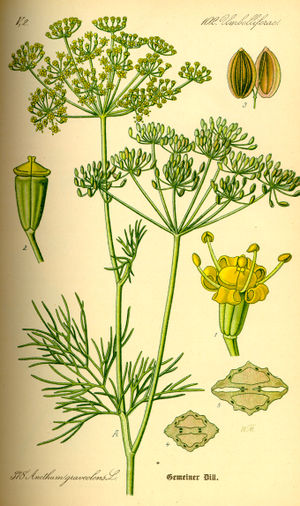Difference between revisions of "Dill"
m |
|||
| Line 1: | Line 1: | ||
| + | [[Image:Illustration Anethum graveolens.jpg|thumb|right]] | ||
| + | |||
'''Dill''' (''Anethum graveolens'') is a short-lived perennial herb. It is the sole species of the genus Anethum, though classified by some botanists in a related genus as Peucedanum graveolens (L.) C.B.Clarke. | '''Dill''' (''Anethum graveolens'') is a short-lived perennial herb. It is the sole species of the genus Anethum, though classified by some botanists in a related genus as Peucedanum graveolens (L.) C.B.Clarke. | ||
| Line 26: | Line 28: | ||
[[Category:Herbs]] [[Category:Medicinal plants]] | [[Category:Herbs]] [[Category:Medicinal plants]] | ||
| + | '''Bold text''' | ||
Latest revision as of 21:53, 6 January 2010
Dill (Anethum graveolens) is a short-lived perennial herb. It is the sole species of the genus Anethum, though classified by some botanists in a related genus as Peucedanum graveolens (L.) C.B.Clarke.
Contents
Cultivation
Successful cultivation requires warm to hot summers with high sunshine levels; even partial shade will reduce the yield substantially. It also prefers rich, well drained soil. The seeds are viable for 3–10 years. Plants intended for seed for further planting should not be grown near fennel, as the two species can hybridise.
The seed is harvested by cutting the flower heads off the stalks when the seed is beginning to ripen. The seed heads are placed upside down in a paper bag and left in a warm dry place for a week. The seeds then separate from the stems easily for storage in an airtight container.
Growth
It grows to 40–60 cm (16–24 in), with slender stems and alternate, finely divided, softly delicate leaves 10–20 cm (3.9–7.9 in) long. The ultimate leaf divisions are 1–2 mm (0.039–0.079 in) broad, slightly broader than the similar leaves of fennel, which are threadlike, less than 1 mm (0.039 in) broad, but harder in texture. The flowers are white to yellow, in small umbels 2–9 cm (0.79–3.5 in) diameter. The seeds are 4–5 mm (0.16–0.20 in) long and 1 mm (0.039 in) thick, and straight to slightly curved with a longitudinally ridged surface.
Uses
Fresh and dried dill leaves (sometimes called "dill weed" to distinguish it from dill seed) are used as herbs.
Like caraway, its fernlike leaves are aromatic, and are used to flavor many foods, such as gravlax (cured salmon), borscht and other soups, and pickles (where the dill flower is sometimes used). Dill is said to be best when used fresh, as it loses its flavor rapidly if dried; however, freeze-dried dill leaves preserve their flavor relatively well for a few months.
Dill seed is used as a spice, with a flavor somewhat similar to caraway, but also resembling that of fresh or dried dill weed. Dill seeds were traditionally used to soothe the stomach after meals. And, dill oil can be extracted from the leaves, stems and seeds of the plant.
In Lao cuisine and parts of northern Thailand and Vietnam dill is known in English as Laotian coriander[6] and Lao cilantro (Lao: ຜັກຊີ, Thai: ผักชีลาว, Vietnamese: Thì là). In the Lao language it is called Phak See and in Thai it is known as Phak Chee Lao.[7] In Lao cuisine, the herb is typically used in mok pa (steamed fish in banana leaf) and several coconut milk-based curries that contain fish or prawns. Lao coriander is also an essential ingredient in Vietnamese dishes like chả cá and canh cá thì là.
In Iran, dill is known as "Shevid" and is sometimes used with rice and called "Shevid-Polo".
Dill weed
- If you lack dill weed substitute dried dill seeds for dill weed for pickles. Use 1/2 the amount of dried seeds for one head of dill weed.
Bold text
